by Cornelis J. Schilt
1. Introduction
When Isaac Newton died in 1727, he left behind an estate, a nice sum of money, and an enormous amount of manuscripts. What he did not leave was a will, and so his heirs were left with the question of what do to with Newton’s written legacy. As Thomas Pellet (a member of the Royal Society brought in to assess whether any of the papers were publishable) soon found out, most of these materials were of a rather esoteric nature. Yes, there were drafts and notebooks relating to Newton’s work in mathematics and natural philosophy, but most of the approximately ten million words that Newton had left dealt with other matters. Copies from alchemical books and manuscripts, for example, with experimental reports by Newton himself. Elaborate drafts related to the history of the early church, the prophesies in the Biblical books of Daniel and Revelation, and other theological treatises. They clearly showed that Newton was not the pious Church of England devotee that many took him for: instead many of his beliefs were heretical and would have cost him dearly had they become publicly known during his lifetime. And then there were thousands of folios related to a work in chronology: a discipline involving the study of ancient monarchies and historical events, to bring these in line with sacred history. Possibly rather shocked by what his eyes had witnessed, Pellet deemed all but one manuscript unworthy for other eyes. Most likely, he tried to protect the legacy of England’s famous son, acting as much in Newton’s interest as in that of the Royal Society and the Crown.1
And so the papers remained hidden for over two centuries, only accessible to a handful of scholars. When the manuscripts were donated to Cambridge in the late nineteenth century by the fifth Earl of Portsmouth, only Newton’s scientific papers were considered of interest: all the other materials were sent back. It was only in 1936 that the non-scientific papers re-emerged, at a London Sotheby’s auction, and it was the economist John Maynard Keynes who bought about half of the lots. He became the first to draw attention to Newton’s other pursuits. In an address he wrote for the tercentenary of Newton’s birth in 1942 which was only celebrated after the war, three months after Keynes had passed away, he provides us with a picture of the unknown Newton:
“In the eighteenth century and since, Newton came to be thought of as the first and greatest of the modern age of scientists, a rationalist, one who taught us to think on the lines of cold and untinctured reason. I do not see him in this light. I do not think that anyone who has pored over the contents of that box which he packed up when he finally left Cambridge in 1696 and which, though partly dispersed, have come down to us, can see him like that. Newton was not the first of the age of reason. He was the last of the magicians, the last of the Babylonians and Sumerians, the last great mind which looked out on the visible and intellectual world with the same eyes as those who began to build our intellectual inheritance rather less than 10,000 years ago. Isaac Newton, a posthumous child born with no father on Christmas Day, 1642, was the last wonderchild to whom the Magi could do sincere and appropriate homage.”2
Today we have access to the majority of Newton’s draft writings through the digitisation practices of Cambridge University Library, the National Library of Israel, and the transcriptions of the Newton Project. What were once the private writings of a man who only selectively showed them to others are now part of the public domain and can be read by anyone. They provide us with a fascinating insight into the creative endeavours of a man who was a true homo universalis: a scientific man and a scholar, who mastered both the readings of the heavens and the readings of ancient sources, and eventually combined them in what was to become his ultimate project.
Unfortunately, Newton’s manuscripts have not reached us unscathed. The various archival and cataloguing practices of collectors and well-willing librarians have resulted in an extremely fragmented paper legacy. Some manuscripts appear to be constructed out of half a dozen original manuscripts, arranged by style or topic. Manuscripts that start halfway a paragraph, or break off abruptly; frankly, it’s a mess. But this is exactly where the digital comes in. Having digital transcriptions of the majority of Newton’s papers allows us to engage in full-scale comparative research, using sophisticated tools and techniques to reconstruct the order in which Newton left these papers, or intended them to be read.
This essay will provide an exposition of Newton’s work in chronology, which led to the posthumously published The Chronology of Ancient Kingdoms Amended, based on the one manuscript that bore Pellet’s seal of approval. It will also present a research programme labelled Corpus Newtonicum, and demonstrate some preliminary results. What this essay also aims at is a cross-over between classical and digital research. It demonstrates how old-school manuscript and book research goes hand in hand with modern digital methods, and how the synergy between both can lead to very fruitful research.
2. Chronology
Somewhere in the 1680s Newton embarked upon a project in chronology. It was a project he would return to in the early 1700s and which he continued until his dying day. Just like Newton’s alchemical studies, it is a project that has been largely ignored by historians of science until far into the twentieth century. It was only in the 1960s that the first systematic study of Newton’s work in chronology appeared, Frank Manuel’s Isaac Newton, Historian. Apart from firmly embedding Newton’s work in contemporary practise and explaining its content on the basis of a handful of manuscripts, he also provided the reader with transcriptions of a number of these manuscripts in a time when they were virtually inaccessible to a larger audience. It took half a century before a second systematic study of Newton’s chronology appeared: Jed Buchwald and Mordechai Feingold’s Newton and the Origin of Civilization. In this study Buchwald and Feingold explore Newton’s interpretation of ancient sources and reconstruct Newton’s astronomical calculations, providing detailed insight in the world of colures and ecliptics.3
Contrary to his lifetime publications, the Chronology was not very well received. There seemed to have been a general feeling that Newton had overstepped certain disciplinary boundaries, and that his erudition and breakthroughs in the physical and mathematical sciences were no guarantees for proper scholarship in other areas. His resurrection of John Marsham’s identification of the Egyptian king Sesostris with the Biblical pharaoh Sesac, combined with his alternative interpretation of so many established ancient sources, resulted in dates for historical events completely unacceptable to contemporary chronologists. But it is not just his contemporaries that looked down upon Newton’s chronological work. In his seminal Never at Rest, Richard Westfall calls the Chronology “[a] work of colossal tedium”. Moreover, he writes that:
“Isaac Newton historian was Isaac Newton heretic engaged in one of his characteristic lifelong activities, the concealment of his heterodox views. In the continuing comments on the Chronology in the eighteenth century, only Arthur Young appears to have perceived Newton’s drift. ‘I am sorry,’ he remarked, ‘to see Principles so favouring the Schemes of the Deists, with so great a Name affix’d to them… [Frank Manuel] interpreted the work as a standard exercise in Christian piety. There was indeed only one slip in the whole performance. By concealing his true purpose so effectively, Newton produced a book with no evident point and no evident form.”4
Newton’s Chronology was certainly not a standard exercise in Christian piety, if only because of his idiosyncratic interpretations and conclusions. But also when it comes to methodology, Newton’s work was far more advanced than that of contemporary chronologists. Unfortunately, Westfall seems to have been a little too eager to discredit Newton’s Chronology, for the quote by Arthur Young does not refer to Newton’s chronological work at all. It instead pertains to the Observations upon the Prophesies, published in 1733, which did indeed provide hints to the informed reader about Newton’s anti-trinitarianism.5
It is rather difficult to assign firm dates to Newton’s chronological writings. For one, we do not have published works to relate to. After all the Chronology of Ancient Kingdoms Amended was published posthumously, based on a fair and seemingly complete manuscript with little corrections. There is no conclusive evidence that this is also Newton’s final or last written copy. For instance, we have a fair number of single page drafts of paragraphs that might well be corrections or alternatives to paragraphs in that fair copy. We do know that Newton composed a summary of his research in 1717, at the request of Princess Caroline, of which an illegal French translation was published in autumn 1725, with accompanying critique.6 Of course, Newton was extremely unhappy about this: not only was his work published without his permission, he was disgusted about the apparently rather bad translation and the misinformed criticism:
“[T]he Observator hath mistaken my Meaning, in the two main Arguments on which the Whole is founded, and hath undertaken to translate and to confute a Paper which he did not understand, and had been zealous to print it without my Consent: tho’ he thought it good for nothing, but to get himself a little Credit, by translating it to be confuted, and confuting his own Translation.”7
All in all, what we have are thousands of folios that are currently organised in about fifty manuscripts. Some of these consist of pages that more or less seem to follow each other, others contain various versions of apparently the same narrative, and yet others are bound volumes of loose folios, reused letters and envelopes. Many of these notes and envelopes can be dated, because they contain Mint notes, an address, or sometimes a direct date, allowing mostly for a terminus post quem.
We can loosely order Newton’s chronology in three groups, related to three stages of writing. The earliest writings are those connected with the Theologia Gentilis Origines Philosophiae, most of which are in Latin. Here we see Newton establishing what would become the backbone of his chronology: the identification of personae in sacred history with mythological figures from ancient history, following a euhemeristic reading of Egyptian and Greek mythology. By employing similar synchronisms to chronology as with his research on the prophesies in Daniel and the Apocalypse, he identifies Noah with Saturn, Noah’s son Cham with Saturn’s son Jupiter, Cham’s son Chus with Mars and so on. But Newton’s synchronistic scheme went even further. For instance, Chus is Mars, but also Hercules, and when Newton writes Mars he is not only referring to the mythological Mars but also to the planet, with its Zodiacal representation and its chemical denotation. Here sacred history meets mythology meets astronomy meets chemistry. This did also imply an idiosyncratic reading of Ovid’s four ages of men: instead of four eras Newton reduces them to four generations, albeit of uncertain length, thereby substantially shortening ancient history:
“The golden age came first, which, without compulsion, without law, of its own accord, kept faith, and did right. Nations securely passed the years in gentle ease. The earth herself without compulsion, untouched by hoe or plowshare, of herself gave all things needful. After Saturn had been banished to the dark land of death, and the world was under the sway of Jupiter, the silver race came in, etc. Then men first sought the shelter of houses. Then first seeds of grain were planted in long furrows, and bullocks groaned beneath the heavy yoke. Next after this, and third in order, came the bronze race, of fiercer disposition, readier to fly to dreadful arms, and yet not heinously criminal. The age of hard iron came last.”8
Harmonising sacred history with ancient mythology would become one of the hallmarks of Newton’s chronology. But he went much further: after establishing a synchronised reading he would return to the ancient sources to try reconstruct a critical text, in true humanist fashion. And despite his firm belief in the superiority of Biblical chronology, he did not hesitate to point at inconsistencies in that same Bible. Interpreting the apocryphal book of Esdras as a copy of the book of Ezra, he suggests a reordering of the materials in Ezra to match the order of Esdras and his established chronology of Median and Persian kings.9
The manuscript from which we have quoted above is a composite construction, possibly by Newton himself, of eighty folios, mainly in Latin, with some parts in English, and with Greek and Hebrew quotations. About half of the text is in a hand that has been identified as Humphrey Newton’s, Isaac’s amanuensis at Cambridge between 1684 and 1689. Apparently Newton asked Humphrey to copy his materials, which Newton subsequently edited: there are abundant deletions and additions in Newton’s own hand. Folios 48r and 50r are particularly interesting, because they contain Newton’s original, followed Humphrey’s copy. Apart from this being the only chronological manuscript that bears Humphrey’s hand, it is exemplary for Newton’s written legacy. Over the course of three centuries a number of historians, collectors and librarians have applied their own cataloguing schemes and re-ordered the manuscripts likewise, thereby destroying or obfuscating many of Newton’s own ordering practices. But even those manuscripts that have apparently seen minimal or no intervention by others pose significant challenges when it comes to understanding how Newton organised his materials, or provide counterintuitive insights. Just one example: all of Newton’s early chronological work seems written in Latin, whereas later material uses English as its main language. But then you come across Yahuda 41, which is headed ‘Chapter II: The Original of Religions’ and starts off in English. Its content however is clearly related to the early Latin materials. At a particular moment the manuscript language switches to Latin, and then back to English, suggesting that is a composite manuscript consisting of at least three parts. But upon closer inspection it turns out that Newton is switching languages halfway through a page, with no apparent change of hand, ink or style…10
Humphrey’s written presence among Newton’s materials has traditionally been used to assign 1684 as an earliest date to Newton’s chronological studies, but it might be that Newton started this project way earlier. In a manuscript that is an amalgam of many loose folios and reused papers, we find a single deleted reference amongst a host of materials in English that are normally referred to a much later stage of Newton’s chronology:
“Now Astronomers tell us that the Equinoxes & Solstices fell at first upon the middle of the signes, afterwards in the time of Eudoxus by the precession of the Equinoxes they came to ye 8th degrees of ye signes & then in the time of Hipparchus to ye 4th degree & at length about the age of Hipparchus to ye beginning of the signes, & since now in the year 1680 they are gone back into about the signes preceding sixt degree of ye signes preceding.”11
It is a mysterious date, since most of the surrounding materials point to a much later period in Newton’s life.12
A second group of materials, building upon the synchronisms of the Theologiae, are related to a work called The Original of Monarchies by the name of their first chapters.13 In addition to harmonising a vast amount of sources based upon an internal reading, Newton now adds an argument from logic, which he calls “the course of nature”.14 Using what he deemed reliable lists of king’s reigns, both ancient and recent, he tried to establish an average length per reign, which according to his calculations would be between 18 and 20 years. He then employed this figure to demonstrate that many ancient monarchies were much younger than their own annals claimed. One or two kings could have reigned for over fifty years each, but not entire lines. Because Newton also included the kings of England in his initial calculation, we can assign rather firm dates to both these manuscripts. One mentions that “[t]he 28 Kings of England (William the Conqueror & his successors) [reigned] 635 ½ years which is 22 2/3 years a piece” while the other mentions 29 kings reigning 648 years.15 With William the Conqueror invading England in 1066, the first manuscript must have been written after the death of William III in March 1701/02 but before the death of Queen Anne in August 1714. Likewise, the second manuscript was written after Queen Anne had died.
The third and last group of writings are related to the published Chronology of Ancient Kingdoms Amended, and the Short Chronicle, which Newton composed in 1717 for Princess Caroline as a summary of his chronological work. Apart from introducing one new and major feature, most of the material that Newton drafted for the Chronology is closely related to the later version of The Original of Monarchies. That major feature however lifted Newton’s chronology to a different dimension. Drawing upon his mastery of astronomy he searched his ancient sources for references to the stars which he used to calculate the exact years when these observations were made. This did mean a sometimes rather idiosyncratic reading of those passages, in particular Hipparchus’s Commentary on a poem by Aratus, the Phaenomena.16 Newton subsequently calibrated his astronomical data with his course of nature calculations and his synchronised readings of ancient texts to arrive a number of remarkable conclusions, most notable his calculation of the year when Jason and the Argonauts sailed out, and the fall of Troy.
When we compare the earlier materials to the materials he readied for publication, including the manuscript from which the Chronology was published, we notice a number of striking differences. When we manage to look through the disordered state of so many drafts, and this is where digital methods are at their best, we notice the sheer amount of quotations and citations, some in marginal notes and references, others in the main text. And indeed, the Chronology contains a similar abundance of references, almost five hundred notes on what were originally 120 folios. At first glance it seems as if Newton has kept track of all the sources he used, for we come across many familiar names: Herodotus, Pliny, Plutarch, Josephus, Dionysius, Pausanias, Strabo and an abundance of Biblical references; very similar to what we find among the draft materials. But on second inspection some names seem to be missing. There are no notes to John Marsham, for instance, and a quick search finds his name mentioned only once, with no reference to any particular work of his. We know that Newton owned Marsham’s Canon Chronicus Aegypiacus, Ebraicus, Graecus, et Disquitiones…, a work he studied thoroughly as the many dog-ears in his copy indicate.17
This is reflected in Newton’s earliest chronological studies: the Theologiae Gentilis contains five references to Marsham’s Canon, with appropriate page numbers. On the other hand, the Chronology has seven references to Samuel Bochart, whose Geographia Sacra was also in Newton’s library, which seems consistent with the draft materials. It is almost as if Newton has purged Marsham from his Chronology, except for the one instance where he could not: the identification of Sesostris with Sesak, “the centerpiece of his revised chronology” which was unquestionably Marsham’s. As Buchwald and Feingold point out, Newton also used Marsham’s Canon as his source for testimonies by Clement of Alexandria and Seneca regarding Greek mysteries, without any acknowledgement.18 The omission of references to Marsham seems less deliberate though when we realise that the one mention in the Chronology is accompanied by lavish praise: “Our great Chronologer, Sir John Marsham”.19 Thus, how exactly did Newton use primary and secondary sources, and did his usage of them change over time?
So far we have highlighted a number of interesting issues and resulting questions about Newton’s originality and inspiration regarding his chronological writings. They already provide us with glimpses of how Newton approached his subject. This was by reading ancient sources and contemporary critics, dog-earing his books and thereby indicating passages he found interesting or useful, taking notes from some of these books, and turning all of this into his own narrative. But if we want to shed more light upon Newton as a composer and truly understand his creativity, it is imperative to bring order to his manuscripts.
3. Order
The research programme Corpus Newtonicum aims at reconstructing Isaac Newton’s working practices through his manuscripts. They contain a blueprint of Newton’s creativity, and can ultimately serve as a case study into our own creative processes.20 The manuscripts that contain Newton’s chronological drafts span thousands of folios with over half a million words, and are therefore extremely suitable to gain insight into Newton’s working methods. Most of the chronological writings can be found among the Yahuda papers, which are held by the National Library of Israel and have been digitised to a high standard.21
The Newton Project provides diplomatic and normalised transcriptions of these, and allows the user to download the underlying XML-files and schemas for private research. These transcriptions allow the reader to actually read Newton’s papers: very often Newton’s hand is not exactly legible, and that is before we take his practice of heavy deletion and minute, scribbly, between-the-lines additions into account. But thanks to the sophisticated use of Text Encoding Initiative (TEI) standards, the transcriptions are way more than a reading aid. Many items of Newton’s writings have been appropriately tagged: notes, deletions and additions and their physical loci, changes of hand, style, and more. Not just for editorial purposes, but with research in mind. This is where the roles of editor and user come together. I firmly believe that digital editing is not an end in itself: it is a first step towards an increased usability of texts and materials. There has to be a second step: using the edited materials. Ideally, the process of digital editing (or for that matter editing in general) should always take this into consideration. The editor has to ask: how would I like others to use my edition. And how would I myself use it? The previous section about Newton’s Chronology has already made extensive use of the transcriptions to merely query Newton’s writings: where do we find evidence of Newton using particular sources? How often does he quote Marsham, or other writers, and at what stage? This is where another aspect of digital transcription comes in: functional mark-up.
One particular type of item that has been tagged are catchwords: the repetition of the first word of the next page at the bottom of the previous page. Often used in early modern printed books, it allowed the printer to order the separately printed pages, and aided the reader. Interestingly, Isaac Newton also made frequent use of catchwords in his draft materials. Just to give an idea, an example:
Figure 1a: Yahuda 25.1a III bottom of folio 1r.
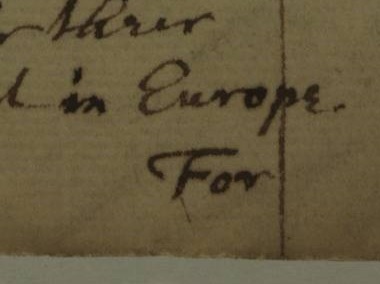
Figure 1b: … and top of folio 2r.
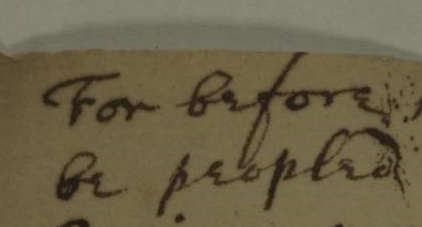
Figure 1a shows the catchword “For”, pointing to the first word on the following page (Figure 1b). As far as we understand, this was not a copy that Newton prepared for publication: he added catchwords for his own benefit. And as it happens, there are quite a number of manuscript pages that end with a catchword that does not match the following page. We also have manuscripts that end abruptly on a catchword, and manuscripts that start halfway through a sentence, presumably indicating that these manuscripts belong to a larger original.
Using some XPath magic, we can identify each of these pages. The following table shows a few entries from a long list of “broken chains”:
Table 1: Systematic search for missing catchwords.
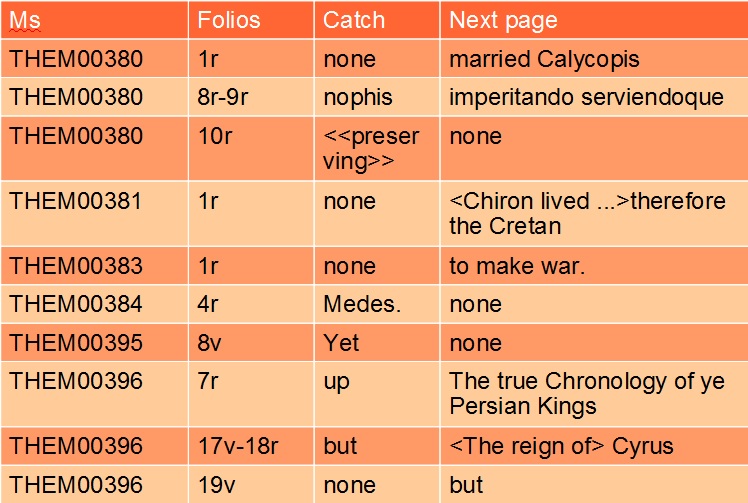
Using Newton Project naming of manuscripts, Table 1 starts with the first folio (1r) of THEM00380 and tells us that this manuscript starts abruptly in the middle of a sentence: “…. married Calycopis.” The second entry tells us that at the end of folio 8r of the same manuscript we find a catchword “nophis”, the last two syllables of the name of the Egyptian pharaoh Amenophis, but that the next folio 9r starts with “imperitando serviendoque”. And as the following entry shows, folio 10r of that same manuscript has a catchword “preserving”, which has been added after deleting another catchword, hence the << >> signs, but there is no next page.
Further down the list I came across some oddities, and I decided to return to the manuscript image to check my results. In a manuscript labelled THEM00376, referring to Yahuda 25.1a III, I found the following catchwords at the bottom of folio 4r:
Figure 2: Yahuda 25.1a III, folio 4r: catchwords “in a”.
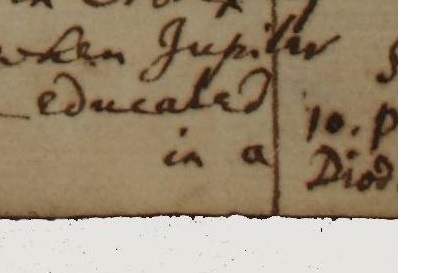
Folio 5r of that manuscript nicely continued the narrative, starting with the same “in a”. But the next couple of pages all had wrong catchwords; moreover, folios 7r and 9r both started with the same words “in a” as folio 5r, and upon closer inspection turned out to be variant versions of the same page:
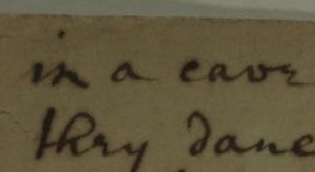
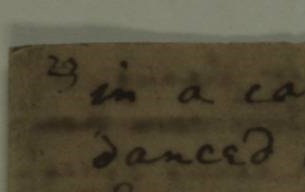
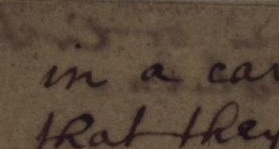
What was more, I could not find any other instance of the catchwords “in a” in my database. And, as I had already found out, many other catchwords remained missing. I initially anticipated to find these somewhere in my database, and that this would just be like solving a giant jigsaw puzzle and joining the right pieces. But it turned out to be far less simple than that.
So, what is going on here? What does this tell us about Newton’s working practices? In the case of the repeated “in a” pages, it seems to me that there have never been any other preceding pages to which these were originally attached. They are variant versions of the same page, starting off with exactly the same sentences but deviating halfway, indicating that Newton actually reused the preceding pages in a new draft of the same materials. At a particular moment, instead of deleting and amending a page, he decided to cast it aside and continue afresh from page 4r onwards, thereby creating a new version of the following page. And in the above case, he did so twice.
In my search for further evidence of this hypothesis, I stumbled upon the following, again from the same Yahuda manuscript:
Figure 3: Yahuda 25.1a III f. 8r.

It may not be immediately obvious, but what we see here is Newton writing a paragraph, and instead of continuing until the end of the page and then writing down the next word as a catchword, he is writing towards that predetermined catchword, hence the white space between “Temples” and “with”. Why? Because that is the word with which the next page starts, indicating that that page already existed before he wrote this page. This another clear example of Newton reusing pages from an earlier draft and composing around them. This also tells us that Newton’s writing practices are not linear: we cannot reconstruct original manuscripts by simply matching catchwords, because some pages are part of a number of these originals. The term ‘original’ suddenly becomes very complicated, although we could return to it in its most basic meaning: ‘first’. The three versions of the “in a” page represent three different stages of writing. By employing versioning techniques we might be able to deduce their order of composition, and thereby form the basis of the real jigsaw puzzle: the chronology of Newton’s Chronology.
On the other hand, we do have a substantial number of catchwords that do not match any other page in the entire corpus. But it seems strange that Newton would write down a catchword and then suddenly stop, to never continue that particular sentence, on multiple occasions. Could it be that there are still a number of Newton manuscripts missing? Not all of the lots that were sold in the 1936 Sotheby auction have been identified, and about a dozen have been sold to buyers that have remained anonymous until the present day. Some manuscripts do resurface, only to return into anonymity once they are sold. Unlike the 1930s when these were sold for the equivalent of a few hundred pounds, some Newtonian manuscripts have increased immensely in value, some reaching six figures as a 2004 Sotheby’s auction in New York showed.22
4. Conclusion
It is fascinating to see how digital editing and analysis can be used in conjunction with older, more close-reading oriented practices in order to shine light upon Newton’s working practices. Using digital versions of Newton’s manuscripts enables us to establish how Newton uses his sources, how he credits other authors or indeed, does not refer to them at all. We can pick up a book owned by Newton, or use its digitised counterpart, and analyse how he used it, and then return to our transcriptions and search for collaborative traces. Directly applying digital techniques to these transcriptions has shown us how Newton is reusing materials, and that we need other forms of textual analysis to properly establish their order of composition.
Digital Humanists and historians are often asked what sorts of new insights their work has brought, and whether the whole ‘digital thing’ is not just a fad, a whim, or even a fetish. I hope this paper has shown how intelligently marked-up digital texts can potentially add so much new insight to topics that have been researched exhaustively. Only now, because of the wealth of digitally available images, transcriptions and resources, are we able to ask questions that hint at both the bigger picture and the minute, the detailed. Zooming in on tiny catchwords has revealed that we might actually have missed a number of Newtonian manuscripts, and that the abundance of those present show us the intricate details of Newton at work, in a way that until now was unthinkable.
- Cf Richard S. Westfall, Never at Rest: A Biography of Isaac Newton (Cambridge: Cambridge University Press, 1980), pp.872-3. For a full account of the history of Newton’s papers, see Sarah Dry, The Newton Papers: The Strange and True Odyssey of Isaac Newton’s Manuscripts (Oxford: Oxford University Press, 2014).
- http://www-history.mcs.st-and.ac.uk/Extras/Keynes_Newton.html.
- Frank Manuel, Isaac Newton, Historian (Cambridge: Cambridge University Press, 1963); Jed Z. Buchwald and Mordechai Feingold, Newton and the Origin of Civilization (Princeton and Oxford: Princeton University Press, 2012).
- Westfall, Never at Rest, p. 815. I am grateful to Rob Iliffe for pointing out this passage.
- See Artur Young, Historial Dissertation on Idolatrous Corruptions in Religion (London: 1734), Vol.2, p.259-64.: “Sir Isaac Newton, whose Observations upon the Prophecys of Daniel and the Apocalypse were published while these sheets were in the press, supposes…” followed by a number of lengthy quotations. Westfall quotes from page 269, but there is no mention in this passage of the Chronology whatsoever.
- Buchwald and Feingold, Origin of Civilization, p. 307-8.
- Isaac Newton, “Remarks upon the Observations Made upon a Chronological Index of Sir Isaac Newton, Translated into French by the Observator, and Publish’d at Paris”, Philosophical Transactions, 1724-1725 33, pp. 315-21, doi: 10.1098/rstl.1724.0060, p. 319
- Yahuda Ms. 16.2 f. 53r, translation Michael Silverthorne, http://www.newtonproject.sussex.ac.uk/view/trasnlation/TRAN00010. Cf. Ibid., f. 54r and Yahuda 17.2, f. 3v for variant versions of this text.
- Newton, Chronology, 369-70. http://www.newtonproject.sussex.ac.uk/view/texts/normalized/THEM00191”/.
- Yahuda Ms. 41.2 f. 16r.
- New College Ms. 361.3f. 252v, http://www.newtonproject.sussex.ac.uk/view/texts/diplomatic/THEM00098. See also Manuel, Isaac Newton Historian, p.18.
- For instance, f. 253v contains a draft of letter by Newton to Guido Grandi, composed in May 1704, and Mint-related notes, with chronology-related materials on the rectors. Similar reused materials that I have come across so far all seem to testify to the chronology materials being added last.
- Keynes Ms. 146, which has no other chapters, and New College Ms. 361.1.B4, which has another four sections that are partially drafts of the same.
- Keynes Ms. 146 f. 15r, New College Ms. 361.1.B4 f. 105r, 106r, 130r.
- Keynes Ms. 146 f. 15r, New College Ms. 361.1.B4 f. 105r.
- Cf. Buchwald and Feingold, Newton and the Origin of Civilization, pp. 246-306 for an extensive treatment of Newton’s methodology.
- Newton’s copy of Marsham is now in Linda Hall Library, Kansas City. What is more, the reader can verify Newton’s use of Marsham for himself, since a substantial number of pages have been digitized. See http://lhldigital.lindahall.org/cdm/compoundobject/collection/philsci/id/139/rec/1.
- Buchwald and Feingold, Origin of Civilization, p. 226. Cf. Ibid., p. 227 for further indebtedness to Marsham.
- Newton, Chronology, p. 70.
- See http://www.corpusnewtonicum.wordpress.com to get a glimpse of how this programme progresses.
- See http://dlib.nli.org.il/R/CKK1I4LA7JBIIMSPAFGNP1MBFPP76VUDTQ6L9ASYKXCMACRSLC-02698?func=collections&collection_id=7856.
- http://sothebys.com/en/auctions/ecatalogue/2004/sir-isaac-newton-highly-important-manuscripts-n08065/lot.509.html Cf. Sotheby’s, Sir Isaac Newton: Highly Important Manuscripts (Sotheby’s 2004).